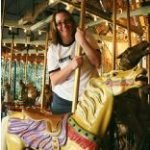I can now safely say that the Cup of Excellence experience is just as exhausting as any other coffee event. Seriously, with around 60 coffees to evaluate, narrow down and precisely judge as the best of the best in a whole country, in the space of a week, this is just as taxing as a barista competition. We don’t have the faces of the coffee in front of us until the end of the day, as opposed to seeing the work and passion of a barista, who is successful if he or she can conjure the producer’s labor and intensity through a performance, but the actual experience is minute-by-minute hard, fast work.

With a morning view like this every day as I step out of my room, however, it’s much easier to stay energized.
From all that I’ve seen and read, as well as heard from Susie Spindler (CoE organization) and the heavy-hitter, veteran judges assembled here this week, this whole thing is about as hyper organized as can be. We meet at 8 in the morning to begin each day of 30 or more coffees. Each table is laid out with 40 cups, 4 each of each coffee, with 2 of each on either side of the table. There are four judges assigned to each table, and the process of moving around and around the table, smelling dry and then wet grounds, taking in the aromas from the breaking of the grounds, and then circling over and over to cup and evaluate on aroma, clean cup, sweetness, acidity, mouthfeel, flavor, aftertaste, balance, and overall impression, takes about an hour and a half for each of 10 coffees. Then we gather in a separate room to discuss each coffee at length and compare scores, while the tireless volunteers clean the cups and room, grind coffee for the next round, and then we begin the whole process all over again.

Meeting of the (Norwegian) minds: Left, Andreas Hertzberg of Solberg & Hansen (and incoming Chair of the CoE Board) chats with Steinar Paulsrud of Kaffebrenneriet as.
There are 31 of us, eight of whom (including myself) are invited Observers. To be an observer means to get your chops down: one must serve as an observer for at least 2 entire CoE competitions before one’s scores actually count toward the final results. Observers do everything the judges do ”complete detailed scoresheets on the 60+ coffees and discuss the nuances, potential defects or instabilities of coffees, and identify each one’s successes. I feel very lucky, since I am a career journalist, not a career cupper, and I have been allowed to ”is infiltrate the right word? ” this uber subculture for a short time. It’s an amazing learning experience, as I am going through every physical and psychological motion that these incredibly practiced and respected cuppers are.

George Howell breaks the crust of his, like, billionth cup.
Just the scoresheets are intimidating. That’s why it’s s important (and commendable) that roasters and baristas around the world use these sheets on a regular basis when evaluating their company’s coffees.

One of my sheets, above.
It was a total treat to run into the awesome Luis Lopez, Nicaragua’s Barista Champion of 2008, in the hotel lobby. Since CoE is such a big deal in these countries, people are contrantly poking their heads in to catch a glimpse of the action. o Luis was kept plenty busy making great coffees.

Cappuccino? Luis has got you covered.
So after lunch yesterday, we boarded a bus for a nearby drymill, where some incredible work with hybridizing coffees is being done. Along the way, I snapped some shots of local people and places.





A mariachi band awaited us when we got to the dry mill. This mill is doing fascinating work in hybridizing coffee to produce strong, more disease resistant varietals.

The director of the mill showed us these cool green burlap sacks of coffee. They seemed small, and he told us that was because they were going to Dubai, where coffee bags have to be “camel size,” which means 20 kilos each: camels carry one bag on each side of their backs.

Yes, I really did tag the side of this sorter with the letters BMAG. The dust was intense!

We wandered outside the mill on our way into the lab to cup some of the hybrids.

Honestly, the hybrids were unimpressive on the table. But I think it was because none seems to have a clean cup. The work is going towards something amazing though, it’s pretty obvious.

From left, Marty of ACEN, me, and Rouki.

The scientists at the lab showed us some of the mother leaves being used for the hybridization process.

The view as we left the lab. A spectacular place.
Goodness! I hear Ric Rhinehart’s voice somewhere in the hotel courtyard outside my window. Gonna go find him and say hi. More news from Nicaragua, and this incredible, 50th Cup of Excellence competition, tomorrow.

